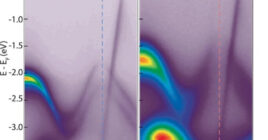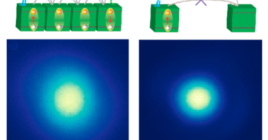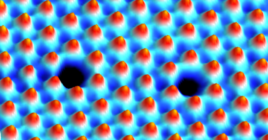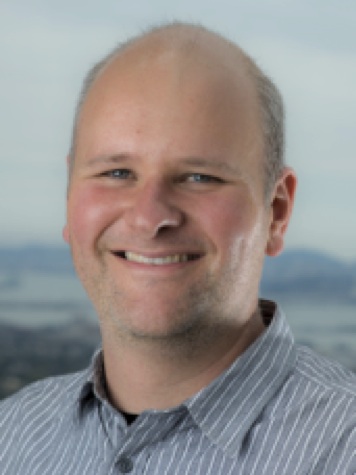
Staff Scientist, Nanofabrication
831.247.4932
Biography
Dr. Schwartzberg is a Bay Area and California native, growing up in the East Bay Area. He performed both his undergraduate and Ph.D. work at UC Santa Cruz under Professor Jin Z. Zhang in Physical Chemistry. While at Santa Cruz, he also worked at Lawrence Livermore National Labs as a graduate research fellow under Professor Thomas Huser. In graduate school, his work focused on metal nanoparticle synthesis and the application of metal nanoparticles, including surface enhanced Raman for sensing, and ultrafast electron dynamics. He received two postdoctoral research fellowships, first with Professor Stephen R. Leone at UC Berkeley, then with Dr. Jeff Urban of the Molecular Foundry. Both of these positions involved the application of his laser physics and chemistry knowledge to implement various spectroscopic imaging techniques. Dr. Schwartzberg’s first staff position was at Sandia National Labs as a senior member of the technical staff where he worked for one year before coming back to the Molecular Foundry.
Research Interests
My work focuses on the deposition of new thin film and multi-layer materials, coupled with ultrafast spectroscopy to characterize both the gas-phase deposition processes, and interfacial electron dynamics. Controlling exciton and electron flow at interfaces is critical to the development of new, high efficiency, energy generation and storage technology. By generating multi-layer superlattice films with highly controlled thickness and material properties, we will have a broad test-bed to examine photoexcited processes in these new materials.
Projects
Ultrafast Dynamics
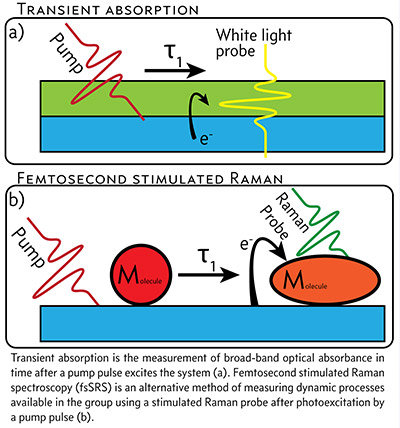
Transient absorption spectroscopy of light harvesting materials
Femtosecond transient absorption spectroscopy (fsTA) enables the visualization of dynamic processes in materials by monitoring the optical absorption of a material following an optical pump excitation. This leads to the clear visualization of processes such as electron/exciton transfer/lifetime, which are critical to the performance of light harvesting devices. Current instrumentation includes an ultrafast transient absorption system with 75 fs time resolution, broad-band visible light probing (320 nm – 800 nm), and broadly tunable pump wavelengths (260 nm – 2800 nm).
Novel atomic layer deposition (ALD) processes
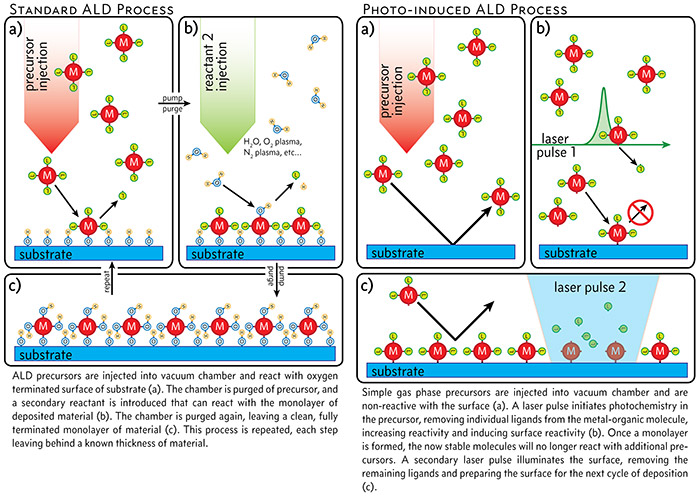
All optical generation of gas phase ALD precursors
ALD is a thin film deposition process where material precursors are deposited one monolayer at a time by self-termination of growth. This is achieved by tuning the reactivity of the precursors such that they can react selectively only with the layer at the surface. The generation of new ALD materials requires careful tuning of precursor-precursor reactivity. Therefore, ALD has been limited to materials with simple reactivity, such as oxides and sulfides. To overcome this difficultly, we are developing a new technique where simple gas phase molecules are photochemically modified to selectively react specifically to the previous material only, thereby removing the requirements of complex chemical synthesis, while allowing for many types of different multi-component materials. Ultimately, the goal will be the deposition of novel perovskite and ceramic materials that can be applied conformally and with high reproducibility over large areas for energy applications.
Nonlinear optical spectroscopy of plasmonic structures
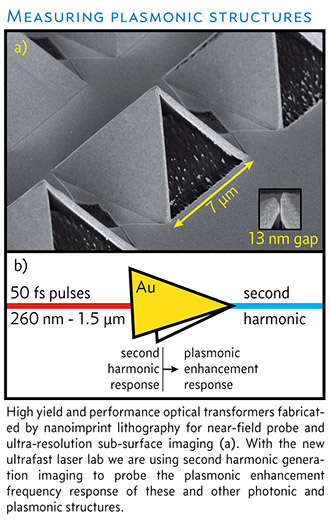
Near-field plasmonic enhancement of nanoimprinted pyramidal optical transformers
Femtosecond transient absorption spectroscopy (fsTA) enables the visualization of dynamic processes in materials by monitoring the optical absorption of a material following an optical pump excitation. This leads to the clear visualization of processes such as electron/exciton transfer/lifetime, which are critical to the performance of light harvesting devices. Current instrumentation includes an ultrafast transient absorption system with 75 fs time resolution, broad-band visible light probing (320 nm – 800 nm), and broadly tunable pump wavelengths (260 nm – 2800 nm).
